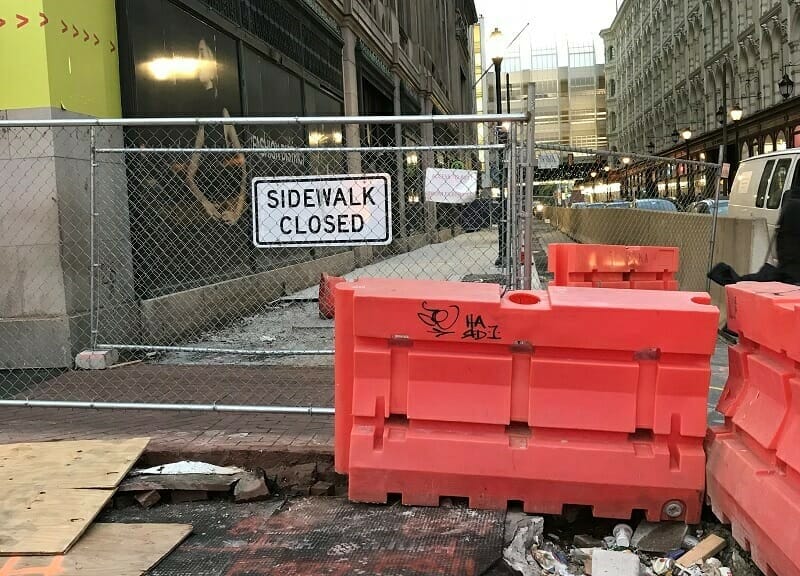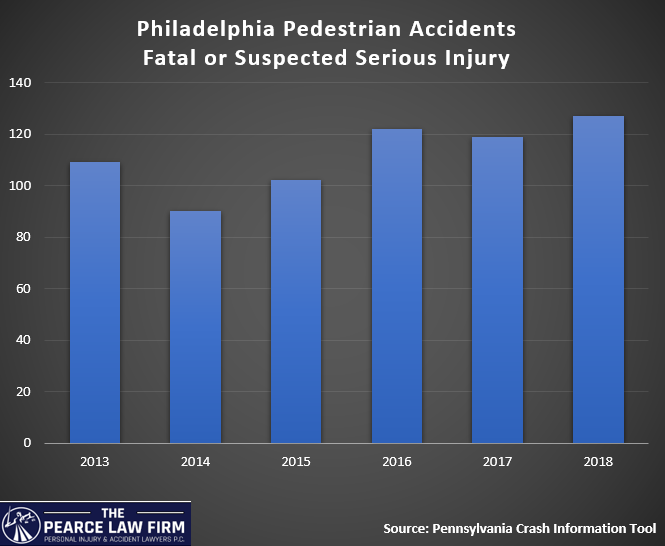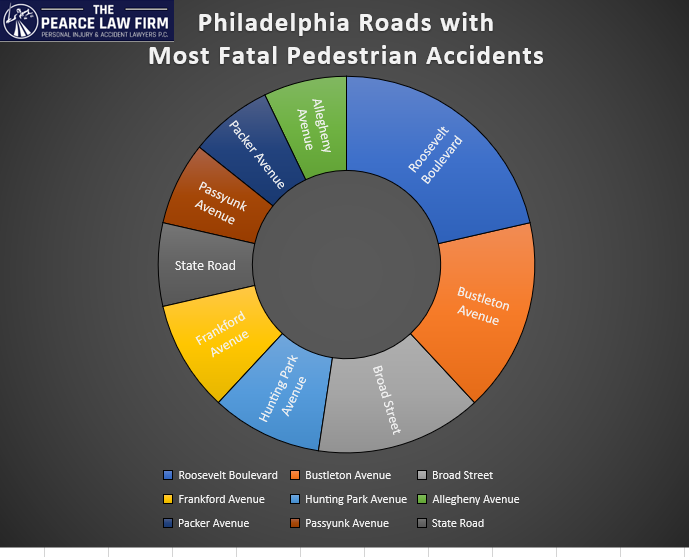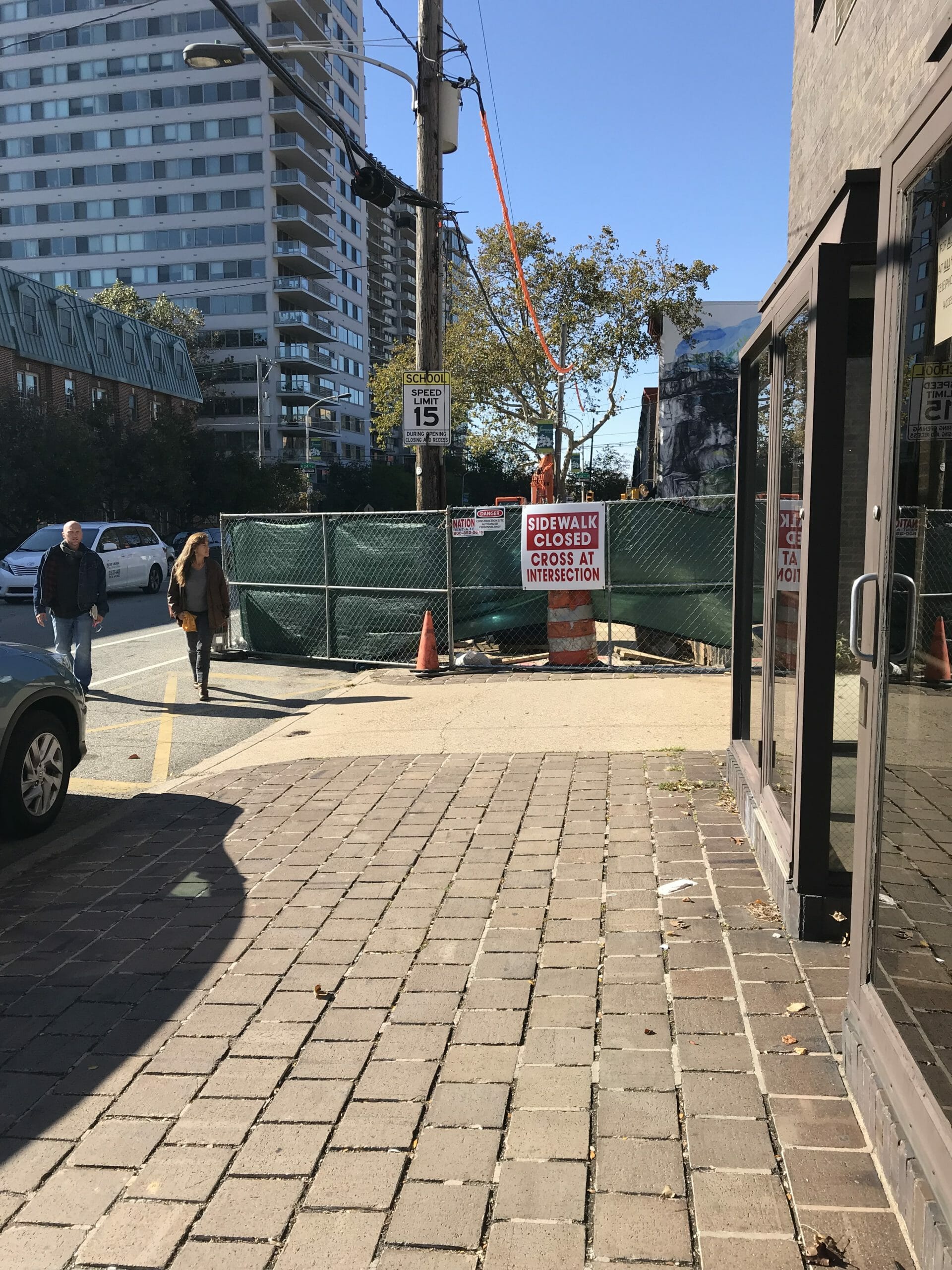Despite the dangers for pedestrians, it has been well documented that Philadelphia is a very walkable city. It checks in at fourth in the United States on the most recent Walk Score list, and has a current Walk Score of 79.
Yet, the mix of construction and walkability doesn’t always mesh well. With Philadelphia’s booming new construction, numerous sidewalks are closed off and walking routes diverted. Whenever developers close off a sidewalk, they often force pedestrians to walk across the street.
Philadelphia’s sidewalk conditions have created a community outcry, including a lawsuit brought against the city in August 2019 by four Philadelphians with disabilities and three advocacy groups. The plaintiffs claim that the city’s walkways are “dilapidated, disintegrating, and teeming with obstructions, making everyday travel difficult and dangerous for the estimated 186,000 people with disabilities that call Philadelphia home.”
Philly’s pedestrians respond: What are the biggest problems?
The Pearce Law Firm, Personal Injury and Accident Lawyers P.C. hired an outside company to survey over 100 Philadelphia residents regarding the biggest problems for Philly’s pedestrians. Some residents felt that drivers need to pay more attention while driving. Others felt that cracked sidewalks were the biggest problem. But most people agree that the biggest problem we currently face is construction areas blocking sidewalks. While there are protective measures in place to penalize construction companies for obstructing walkways, most residents feel that they aren’t going far enough.
Here are the poll results:
Philadelphia Pedestrian Fatality and Injury Data
In an effort to raise awareness and improve pedestrian safety conditions in Philadelphia, The Pearce Law Firm, Personal Injury and Accident Lawyers P.C. hired an outside firm to compile public data on pedestrian injuries and fatalities in Philadelphia.
According to PennDOT’s Crash Information Tool (PCIT), in 2018 alone, there were 1,540 pedestrian accidents in Philadelphia and 127 resulted in “Fatal or Suspected Serious Injury”. This unacceptable number of pedestrian accidents is a reflection of a continuing problem that has plagued Philadelphia for years.
Below, we will outline the most dangerous roads for pedestrians and provide statistical information regarding the annual rates of accidents, injuries and fatalities in Philadelphia.
Roads in Philadelphia with the most fatal pedestrian accidents:
The chart below shows the distribution of fatal pedestrian accident locations in 2018, based on PCIT’s data on confirmed fatal crashes involving pedestrians:
Roosevelt Boulevard was the location for the highest number of pedestrian fatalities in 2018. This dangerous road is infamous for the speeders, adding additional danger to those who frequently commute through this area. Drivers on Roosevelt Boulevard were responsible for 9 pedestrian fatalities during this time period. Bustleton Avenue and Broad Street were not far behind, accounting for 13 pedestrian fatalities between the two roads.
See below for the exact number of fatalities that took place during this time period:
- Roosevelt Boulevard – 9
- Bustleton Avenue – 7
- Broad Street – 6
- Frankford Avenue – 5
- Hunting Park Avenue – 4
- Allegheny Avenue – 3
- Packer Avenue – 3
- Passyunk Avenue – 3
- State Road – 3
All data was compiled using public data from https://crashinfo.penndot.gov/PCIT/queryTool.html.
Making Philadelphia Streets Walkable
With Philadelphia’s booming new construction, numerous sidewalks are closed off and walking routes diverted. Whenever developers close off a sidewalk, they often force pedestrians to walk across the street and sometimes on the street directly facing oncoming traffic. This is extremely dangerous for elderly residents and distracted walkers.
When it comes down to it, the lines for when developers have to provide a covered walkway for pedestrians during a construction project are blurry, and need to be more defined. A covered walkway would be a temporary pedestrian sidewalk canopy that is intended to protect individuals from falling objects. As the law in Philadelphia stands, all a developer needs is a licensed engineer to state a covered walkway is “impracticable” to get out of having to provide a covered walkway while performing construction It is easy for developers and contractors to get around the law when they are the ones that pay the engineer to do the assessment. Although the Streets Department reviews the engineer report, critics claim they are routinely granted and rarely denied.
In 2017, City Council passed the “Protected Walkway Bill.” The law was amended to state that if covered walkways are “impracticable,” the law now requires the developer seeking a permit to close the sidewalk to also have an engineer analyze whether an uncovered “protected walkway” can be established that will adequately protect public safety and not unduly impact traffic safety. These “protected walkways” usually take the form of the large orange plastic barriers forming a “cattle chute.” However, again it is the developer’s paid engineer who is doing the analysis of whether a protected walkway can safely be established and not unduly impact traffic safety. There is skepticism whether the new law has done anything. In fact, it was reported that the Streets Department testified in favor of the Protected Walkway Bill, “saying that it largely just put into legislative language what it was doing already.”
One solution is to hire more inspectors for the Streets Department. In fact, one article noted that there are only 6 inspectors for the “Right of Way Unit.” These six inspectors are expected to handle over 15,000 work orders. In fact, there are over 4,600 “requests” to inspect that are waiting to be addressed from 311 calls and other sources.
Another real solution would be to make it very costly for contractors to have a sidewalk closure. Currently, the permit fee to completely close a sidewalk in Center City or University City is $4.50-per-foot-per-week. Thus, some contractors are happy to just pay the fee and pay for an engineer to author an “independent” report that states it is impracticable to construct a walkway.
Jim Kenney, Philadelphia’s mayor, ran for office in 2015 on a campaign that focused on improving the safety measures for Philadelphia’s streets. His campaign focused on five city-wide improvement platforms, one of which being safe passage for pedestrians. That being said, some neighborhood activists are disappointed by the lack of results, claiming that sidewalk closures remain a safety hazard amidst the ever-present construction.
Unfortunately, the idea of large increases in fines for sidewalk closures, proposed by Mayor Jim Kenney when he was still in Council, has reportedly fallen by the wayside. On the issue of sidewalk closures due to construction, critics claim that Mayor Kenney was a much stronger advocate while on City Council than as Mayor.
As reported by the Philadelphia Inquirer, which called the Protected Walkway Bill a “watered down bill,” a former Streets Department official commented, “On this issue, Councilman Kenney would be appalled with Mayor Kenney.” So, despite the new Protected Walkway Bill passed in 2017, Philadelphia still has sidewalks all over the city closed, making it more dangerous for pedestrians.
That doesn’t mean Kenney and his administration haven’t been trying to make Philadelphia safer for pedestrians. Kenney officially signed Executive Order 11-16, which created the Philadelphia Vision Zero Task Force, on November 7, 2016. Kenney said that Vision Zero’s goal is to reduce traffic-related deaths from the city’s current rate of 100 per year to zero by 2030. Vision Zero plans to carry out this lofty goal by re-designing dangerous roads, investing in road safety education, and empowering traffic safety officers.
Also, as of February 2019, Philadelphia’s Streets Department launched an online interactive map that gives the public real-time information about street and sidewalk closures. The map displays the locations of street and sidewalk closure permits. The map includes detailed information on the permit requester, permitted time of closure and even comments from the city’s Streets Department.
There are also Philadelphia pedestrian advocacy groups like The Bicycle Coalition of Greater Philadelphia and Feet First Philly that encourage the city’s thousands of daily walkers and bicyclists to report illegal closures of sidewalks, bike lanes and dangerous construction zones. In fact, the City of Philadelphia has joined The Bicycle Coalition in a pilot program for residents to report problems with construction disruptions on sidewalks or bike lanes.
Feet First Philly wants to have enough documentation to pressure the Streets Department to enact harsher fees on construction companies that don’t put up safe sidewalk detours. This group also wants disclosures between the Streets Department and developers to be made public.
Of course, pedestrian safety is a two-way street. While nobody denies the hazards of construction sites and walking in the street, pedestrians and drivers need to be more vigilant—which means no texting while walking.
Making Philadelphia an even safer city for pedestrians is going to take a team effort. With enough cooperation and determination from both law enforcement and the public, Philly could improve its future Walk Score survey and improve pedestrian safety.
Pedestrian Safety Tips:
While it is impossible to expect the city to become a safe place for pedestrians and drivers overnight, there are several strategies that pedestrians can employ to enhance their personal safety. The Center for Disease Control (CDC) has recommended these three safety practices:
Wear Brightly Colored Clothing. Wearing brightly colored and reflective clothing helps alert drivers to the presence of a pedestrian. Especially at night, it can be extremely difficult to see pedestrians if they are dressed in dark-colored clothing. Taking simple preventative measures, like wearing a bright colored or white (reflective) shirt can help everyone to safeguard pedestrians.
Cross at Crosswalk. While it might be tempting to cross the street in the middle of the road, it is always safer to take the few extra steps to the crosswalk to ensure safe passage. Cars can quickly turn corners or emerge from other locations and become a deadly hazard. For your own safety and the protection of those around you, only cross at designated locations.
Use Pedestrian Walkways. Similarly, always used approved pedestrian walkways. If a sidewalk is closed due to construction, it is always safer to cross the street at a crosswalk or take an alternate path to reach your destination. Leave plenty of time to get to where you are going so that you can arrive safely.
The Pearce Law Firm, Personal Injury and Accident Lawyers P.C. likes to see pedestrians on sidewalks and not in the streets where injuries are more likely to occur. Anyone injured in a pedestrian accident who is the victim of a negligent driver should speak to an experienced personal injury lawyer to protect their rights.











